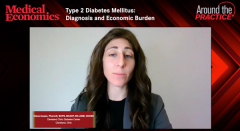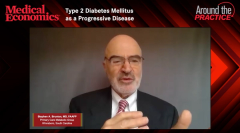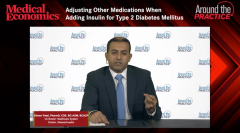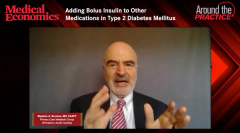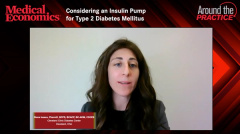
Factors to consider when initiating insulin therapy
Episodes in this series

Dhiren Patel, PharmD, CDE, BC-ADM, BCACP: We just learned that many patients with type 2 diabetes are going to be on insulin. Dr Brunton, what percentage of patients do you see, or even those with type 2 diabetes in general, who are on insulin? We talked about a lot of patients coming in who are on insulin. What do those numbers look like? Talk to me about what you’re seeing in your patient population.
Stephen A. Brunton, MD, FAAFP: There are several roles that insulin has. Obviously, in a patient who has high insulin or is acidotic, insulin is critical in terms of when you see that they are glucotoxic. That’s a different situation.
In terms of where we look at maintenance therapy, probably about 20% of patients are on insulin therapy. That may be changing a bit now with GLP1 agonists, but there is still a critical role with insulin because there’s no limit to the amount of control you can get. My estimate would be 20%. In the patient population that I work with [at Primary Care Metabolic Group], there is a high percentage of Hispanic patients with large prevalence of diabetes, and it is probably a bit higher, probably 25% to 30%, in that patient population.
Dhiren Patel, PharmD, CDE, BC-ADM, BCACP: How does that change as we go to the continuum in the endocrine world? Dr Busch, talk to me about the profile of what you’re seeing.
Robert Busch, MD: We [at Albany Medical College Faculty Practice] are in an area where we have good managed care, so GLP is affordable. With both guidelines, our first injectable should be a GLP. Some people think, “If the beta cell doesn’t work, the GLP is not going to work.” You can give GLP early because 1 of the things it does is increase insulin release in a glucose-dependent manner. Even if the beta cell doesn’t work, you still lower the appearance of sugar by lowering appetite, delaying stomach emptying, and very importantly, lowering glucagon so the liver makes less sugar.
In the head-to-head studies with GLP vs basal insulin, whichever GLP you’re using, you’ll usually have better A1C [glycated hemoglobin] reduction than basal insulin because GLP is low in fasting and postprandial testing. The basal insulin lowers it.
In our world, because the patient is referred in, they usually have not been on a GLP. We’re adding GLP to the regimen as long as it’s affordable and as long as the patient can tolerate it. Unfortunately, a fair number of patients can’t tolerate any GLP no matter what tricks you use. If they have pancreatitis, that’s probably the more exclusionary thing for GLP vs medullary carcinoma of the thyroid, which is pretty rare. We always try GLP first and then add insulin afterward. It’s easy to add insulin for someone who is on an injectable GLP because they were already on the injection, so there is no new fear of the injection because they’re already taking a weekly injectable or whatever before.
I would think that it’s a little less than that in our world, but for some endocrinologists, if they know primary care doctors are using a lot of GLP, they’ll probably have a higher use of insulin because the patient has already been on a GLP.
Dhiren Patel, PharmD, CDE, BC-ADM, BCACP: Isaacs, you’re a clinical pharmacist. I know for me, we’re very involved in starting patients on insulin and some of the immediate follow-up where our colleagues might not be able to get them back in for a few weeks. Do you see more use of it? Are you seeing more patients? Talk to me about your patients and the profile that you are seeing.
Diana Isaacs, PharmD, BCPS, BCACP, BC-ADM, CDCES: I was thinking that I see a lot of it. I would see a lot of my patients with type 2 diabetes, and it could even be about half of them using insulin. That’s probably some of the nature of the referrals that I get. I help to titrate that insulin and determine when we have to add real-time insulin. We also tend to have pretty complex patients who we see here at the Cleveland Clinic: a lot of post-transplant types of patients, people with a lot of other comorbidities that may make it more challenging to be able to use GLP1 agonists and SGLT2 inhibitors, people with intolerance to those, or patients on high-dose steroids or other therapies where they are going to need insulin to reach their glycemic target despite being on other agents.
Stephen A. Brunton, MD, FAAFP: An important issue here may be in terms of your practice. One of the things we do wrong is that we may start people on 10 units, and they stay on that forever. You have this therapeutic inertia that we discussed previously. Another problem is that we may be over-basalizing patients. We keep on increasing the basal insulin dosage, and we’re increasing and increasing, and at some point in time, you just don’t get any benefit.
Dhiren Patel, PharmD, CDE, BC-ADM, BCACP: You’re telling me there’s no max dose? That’s what we learned.
Stephen A. Brunton, MD, FAAFP: You can maximize the dose, but you’re not going to get much of a benefit other than more hypoglycemia.
Diana Isaacs, PharmD, BCPS, BCACP, BC-ADM, CDCES: It’s funny you mentioned that because I do a ton of CGM [continuous glucose monitoring]. Starting people on CGM, 1 of the most common things I see is that people are over-basalized. They have a ton of overnight hypoglycemia, and what’s happening is that we’re increasing that dose trying to get the A1C target. In trying to do that, we are causing so much unrecognized hypoglycemia.
Stephen A. Brunton, MD, FAAFP: That’s an important point. We say to fix fasting levels first, but when we’re trying to get to that target, the postprandial glucose becomes more important the closer we get. I know we’re going to talk about this in terms of titration, using some bolus, and giving patients the appropriate amount of insulin, but we’ve been so educated about using basal insulin, and we need to learn how to use it appropriately.
Newsletter
Stay informed and empowered with Medical Economics enewsletter, delivering expert insights, financial strategies, practice management tips and technology trends — tailored for today’s physicians.

